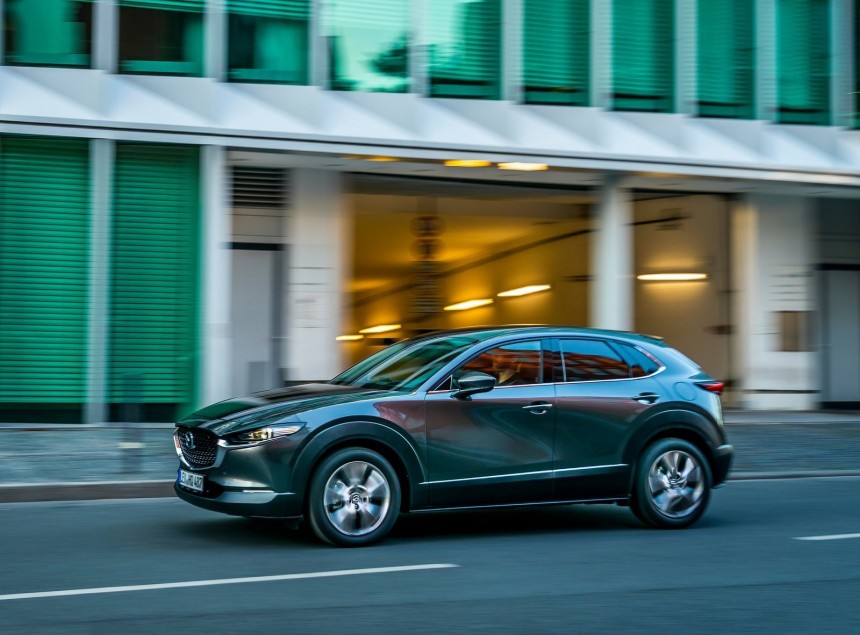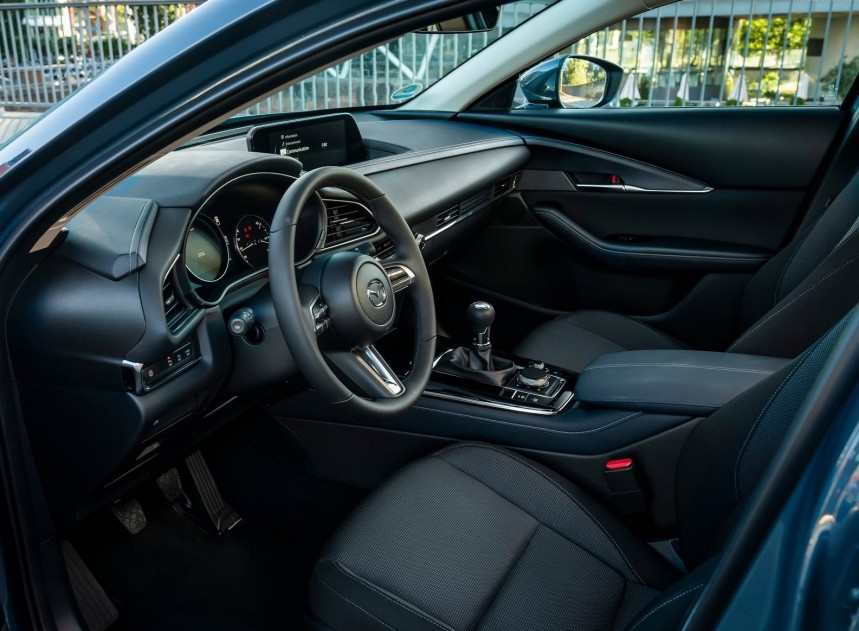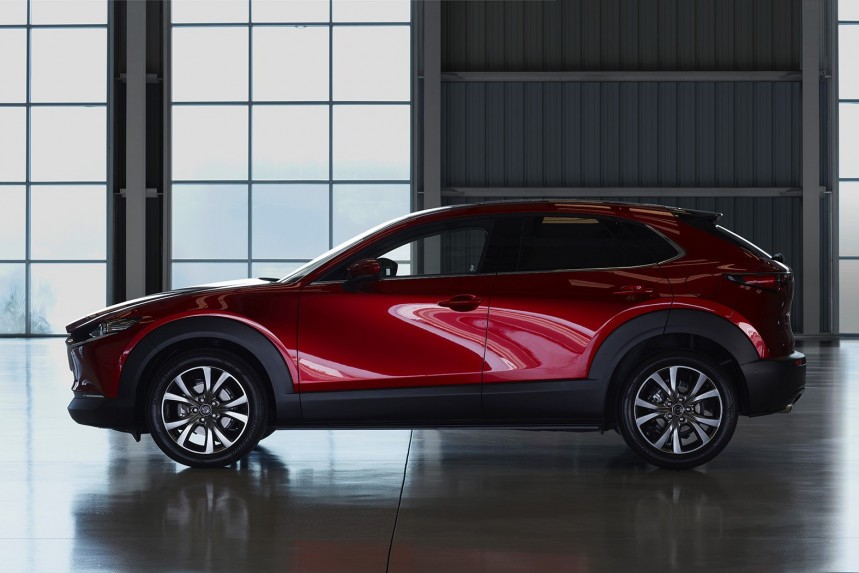The spectacular evolution of Mazdas in terms of design has led to the impression that they are trying hard to look like no one else in the automotive world. Remarkable effort, yet this is a risky kind of move that can take a brand out of the customers' sight and expectations.
Well, only if it reaches an exaggerated level. And, after a consistent bunch of striking original styling approaches, here comes the Mazda CX-30, confirming the brand’s management was aware about the mentioned danger. The CX-30 illustrates, without any hiatus or deviant innuendo, the typical concept of a modern and dynamic subcompact family car. Materialized according to the Mazda contemporary Kodo style, of course.
Approach
There are many notions referring to anything that is better than good: superior, excellent, outstanding, formidable. Yet, in our quest for supremacy and more, we might forget what the notion of “optimal” is about. Fortunately, the Mazda CX-30 is here, to remind us about it. After all, we are individuals of the human kind – tall, heavy, two legs, two arms and a head with some brains inside. Our very basic form of social organization is the family, with certain variations in size and structure.
A car about 173 in (4.40 m) long, 70 in (1.80 m) wide and 60 in (1.54 m) high should be large enough to serve all the transportation needs of a typical familial cell (couple with one or two kids). This looks pretty much like the size of an ordinary compact hatchback, doesn’t it? Until the apparition of the CX-30, Mazda was a little too exposed in this category. Their Mazda3 hatchback, with its coupe-like design, is a sporty car, not really practical family vehicle.
Their range also includes the CX-3 (a bit tight inside) and the CX-5 (aspiring to a higher, premium-like status), two somewhat fancy crossover-SUVs, assimilable to the subcompact and compact categories. In theory, Mazda's compact range was complete. That said, none of those models had the fine calibration expected from a 100% family-use suited modern vehicle. And, because people love SUVs nowadays, the Mazda CX-30 came in a corresponding guise. As many have already guessed by now, under its body lies the technical platform of the Mazda3.
The rotary controller of the multimedia device and a small volume button are situated down, between the seats. The controller is easy to find without lowering your line of sight and the volume can also be adjusted by using the buttons on the multifunctional steering wheel.
Fans of the digital era will probably be disappointed by the classic-sporty analogue instrument panel. Somewhat funny: the dial in the middle looks just like a traditional speedometer but is in fact a round configurable digital display. Those who see the CX-30 as something other than a gadget or an appliance will surely appreciate the layout and design of the instruments.
The chromatic registry of the interior also illustrates the classic-sporty genre. The shape of the seats was carefully studied, and they offer definitely pleasant sitting conditions. The cabin is more than spacious, and all four passengers will notice this. However, seating three passengers on the rear bench seat is not something enjoyable to do on a daily basis. The standard trunk volume is 430 liters – a more than reasonable value for the compact segment.
Briefly, the SPCCI is a unique combustion method to combine the free-revving performance of a gasoline engine with the superior torque characteristic and low fuel consumption of a diesel. This is an engine with a high compression ratio (16,5:1), able to develop 183 hp at 6000 rpm. Its maximum torque reaches 240 Nm (177 lb-ft) at 4000 rpm.
On the North American market, the engine range starts with the aspirated Skyactiv-G engine of 2.5 liters, able to develop 186 hp at 6000 rpm and a maximum torque of 186 lb-ft (252 Nm) at 4000 rpm, mated with a 6-speed automatic gearbox.
For those who want more, a Skyactiv-G engine of the same displacement offers 250 hp thanks to turbocharging. The CX-30 2.5 Turbo is a bit more expensive, but those who prefer to have a more consistent potential under the loud pedal should agree paying for it. Anyway, the “older” Skyactiv-G engines have a solid reputation on their side.
Actually, all Skyactiv gasoline engines are equipped with Mazda's so-called M-Hybrid system. In fact, this is a mild-hybrid concept, featuring an integrated starter-generator and a small lithium-ion battery mounted longitudinally under the floor, behind the engine bay. The good figures regarding consumption of the Mazda CX-30 are achieved thanks to its contribution to the energy equation of the vehicle (regenerative braking included).
In the end, we wouldn’t leave you with a perception of an eco/slow kind of character regarding the Mazda CX-30. It can be as fuel efficient or as fast as you like. Its technical platform was designed to provide convincing dynamic abilities. Proof: the GVC (G-Vectoring Control Plus) is standard, working to refine the stability and responses of the car in motion. If you want, you can also have the i-Activ AWD, good for extra grip in shallow grip conditions.
Mazda CX-30 doesn’t fall short of expectations, no matter the perspective you consider. The European price spectrum goes from roughly €22,000 to €27,000 (the acquisition of the 2.5 and 2.5 Turbo versions is not promoted), while Americans would have to pay roughly between $22,050 (for a 2.5 S) and $34,050 (for a 2.5 Turbo Premium Plus). The cheapest 2.5 Turbo comes at $30,050. Our advice: don’t forget to give a chance to the i-Activ AWD transmission, it will surely make a difference in critical grip conditions.
Their range also includes the CX-3 (a bit tight inside) and the CX-5 (aspiring to a higher, premium-like status), two somewhat fancy crossover-SUVs, assimilable to the subcompact and compact categories. In theory, Mazda's compact range was complete. That said, none of those models had the fine calibration expected from a 100% family-use suited modern vehicle. And, because people love SUVs nowadays, the Mazda CX-30 came in a corresponding guise. As many have already guessed by now, under its body lies the technical platform of the Mazda3.
Ambiance
The CX-30's interior design is one of the most elaborated in its segment. The idea of the wrap-around dashboard might make you think of Jaguar, just like the quite nice-looking fit and finish. Thin metal details add a note of refinement to the landscape. We really appreciate the way the dashboard is organized: the multimedia screen (diagonal of 8.8 inches) is located as high as possible, at the base of the windshield, while the buttons of the heating-ventilation system are completely set apart from everything else, in the middle of the center console.The rotary controller of the multimedia device and a small volume button are situated down, between the seats. The controller is easy to find without lowering your line of sight and the volume can also be adjusted by using the buttons on the multifunctional steering wheel.
The chromatic registry of the interior also illustrates the classic-sporty genre. The shape of the seats was carefully studied, and they offer definitely pleasant sitting conditions. The cabin is more than spacious, and all four passengers will notice this. However, seating three passengers on the rear bench seat is not something enjoyable to do on a daily basis. The standard trunk volume is 430 liters – a more than reasonable value for the compact segment.
Thrust
Perhaps the general concept of the CX-30 is aligned with the trendy fashion criteria, but its technical content still wears a clear Mazda signature. The 4-cylinder Skyactiv-X gasoline engine mounted under the hood of the CX-30 S has a displacement of 2.0 liters and is showcasing the company's revolutionary Spark Plug Controlled Compression Ignition (SPCCI) technology.Briefly, the SPCCI is a unique combustion method to combine the free-revving performance of a gasoline engine with the superior torque characteristic and low fuel consumption of a diesel. This is an engine with a high compression ratio (16,5:1), able to develop 183 hp at 6000 rpm. Its maximum torque reaches 240 Nm (177 lb-ft) at 4000 rpm.
On the North American market, the engine range starts with the aspirated Skyactiv-G engine of 2.5 liters, able to develop 186 hp at 6000 rpm and a maximum torque of 186 lb-ft (252 Nm) at 4000 rpm, mated with a 6-speed automatic gearbox.
Actually, all Skyactiv gasoline engines are equipped with Mazda's so-called M-Hybrid system. In fact, this is a mild-hybrid concept, featuring an integrated starter-generator and a small lithium-ion battery mounted longitudinally under the floor, behind the engine bay. The good figures regarding consumption of the Mazda CX-30 are achieved thanks to its contribution to the energy equation of the vehicle (regenerative braking included).
In the end, we wouldn’t leave you with a perception of an eco/slow kind of character regarding the Mazda CX-30. It can be as fuel efficient or as fast as you like. Its technical platform was designed to provide convincing dynamic abilities. Proof: the GVC (G-Vectoring Control Plus) is standard, working to refine the stability and responses of the car in motion. If you want, you can also have the i-Activ AWD, good for extra grip in shallow grip conditions.
What to pay for
The structure and content of the trim levels differs significantly depending the market. While in Europe, in certain countries, you can have the CX-30 as Standard, Plus, GT or GT Plus, in the U.S. it is offered as Select, Preferred, Premium and Premium Plus. Accordingly, we deduce that the European clientele is more sensitive to the dynamic-sporty side of the car, while Americans are more interestedin its characteristics of comfort and refinement.Mazda CX-30 doesn’t fall short of expectations, no matter the perspective you consider. The European price spectrum goes from roughly €22,000 to €27,000 (the acquisition of the 2.5 and 2.5 Turbo versions is not promoted), while Americans would have to pay roughly between $22,050 (for a 2.5 S) and $34,050 (for a 2.5 Turbo Premium Plus). The cheapest 2.5 Turbo comes at $30,050. Our advice: don’t forget to give a chance to the i-Activ AWD transmission, it will surely make a difference in critical grip conditions.











































